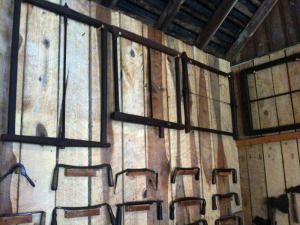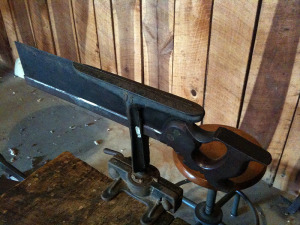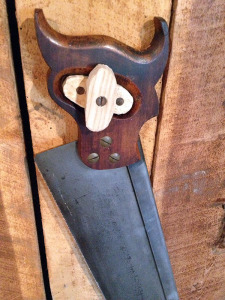Wisdom of Youth
Working in a living history museum is an interesting experience that teaches me about woodworking every time I’m there. You never know what task will come up and one minute you are pedaling the lathe and the next you are sharpening a drawknife all while being observed by guests and peppered with questions. The only thing more unpredictable than the tasks are the questions. Some of the questions you grow to expect:
“What are you building?”
“What kind of wood is that?”
“Do you use power tools when no one is looking?”
 That last one always makes me laugh. The rest of the time it is anyone’s guess as to what the questions may be. This past weekend at the Steppingstone Museum was our annual Celtic Festival so we were busy. I had questions about the treadle lathe, questions about the treadle scroll saw. I had a question about a specific joint found on an antique chair which turned into a historical discussion of regional joinery differences in colonial America. I had questions about lumber drying and the import of exotic woods. I had a question about the different kinds of frame saws on the wall. I was asked why Japanese saws are so different from Western saws (help me Wilbur). I was asked for my opinion on which wood would be best for making a martial arts practice sword. I was asked if I know how to cut “those dove thingies that are on my drawers”. Of course that required a demonstration. There are too many more to remember but in every case the answer usually involved some kind of demonstration and any where possible, I try to involve the asker in the demonstration.
That last one always makes me laugh. The rest of the time it is anyone’s guess as to what the questions may be. This past weekend at the Steppingstone Museum was our annual Celtic Festival so we were busy. I had questions about the treadle lathe, questions about the treadle scroll saw. I had a question about a specific joint found on an antique chair which turned into a historical discussion of regional joinery differences in colonial America. I had questions about lumber drying and the import of exotic woods. I had a question about the different kinds of frame saws on the wall. I was asked why Japanese saws are so different from Western saws (help me Wilbur). I was asked for my opinion on which wood would be best for making a martial arts practice sword. I was asked if I know how to cut “those dove thingies that are on my drawers”. Of course that required a demonstration. There are too many more to remember but in every case the answer usually involved some kind of demonstration and any where possible, I try to involve the asker in the demonstration.
 If anyone thinks that woodworking is dying then they need to come spend a Saturday with me at the museum. The old guys rarely ask questions. They like to watch or they make comments about how it was done in there day. The reality is that today’s senior citizens used powers tools in their youth and the prime of their woodworking was the height of the power tool craze. All of these questions come from teenagers and 20 and 30 somethings. There are a few 8-10 year olds in there too, but they usually just like to play with the eggbeater drills and a piece of Pine. I have seen sullen teenage boys who don’t speak to anyone other than with their thumbs, put down their phone and engage in an honest to goodness conversation about woodworking. They are excited when they see someone actually building something. Their faces light up when I offer them the spokeshave/drawknife/hand saw/hand plane and ask them if they want to try it. Suddenly the phone is forgotten and they are working away on a piece of scrap wood.
If anyone thinks that woodworking is dying then they need to come spend a Saturday with me at the museum. The old guys rarely ask questions. They like to watch or they make comments about how it was done in there day. The reality is that today’s senior citizens used powers tools in their youth and the prime of their woodworking was the height of the power tool craze. All of these questions come from teenagers and 20 and 30 somethings. There are a few 8-10 year olds in there too, but they usually just like to play with the eggbeater drills and a piece of Pine. I have seen sullen teenage boys who don’t speak to anyone other than with their thumbs, put down their phone and engage in an honest to goodness conversation about woodworking. They are excited when they see someone actually building something. Their faces light up when I offer them the spokeshave/drawknife/hand saw/hand plane and ask them if they want to try it. Suddenly the phone is forgotten and they are working away on a piece of scrap wood.
The funny thing is that the 20 and 30 somethings always decline my offer to try the tool. They usually offer some excuse like, “I don’t want to mess up your wood, or ruin the tool.” They continue to ask questions but continue to decline any opportunity to try the work themselves. It was this weekend when this pattern suddenly made sense to me.
 I had just finished sharpening a back saw (while answering questions about rake and fleam from a 30 something software engineer) and had discovered that there was no place to hang this saw on the wall. I grabbed a chunk of White Oak and traced the interior of the handle onto the wood. After sawing out the pattern at the treadle scroll saw, I set to work paring the shape smooth and for a snug fit. My chisel was a bit dull and I was having to work harder than I should but it was such a small job that I figured I would just power through it. One of the 30 somethings gathered around said, “That looks like really hard wood, it must be hard work.” I admitted that White Oak is pretty hard but I really should sharpen my chisel.
I had just finished sharpening a back saw (while answering questions about rake and fleam from a 30 something software engineer) and had discovered that there was no place to hang this saw on the wall. I grabbed a chunk of White Oak and traced the interior of the handle onto the wood. After sawing out the pattern at the treadle scroll saw, I set to work paring the shape smooth and for a snug fit. My chisel was a bit dull and I was having to work harder than I should but it was such a small job that I figured I would just power through it. One of the 30 somethings gathered around said, “That looks like really hard wood, it must be hard work.” I admitted that White Oak is pretty hard but I really should sharpen my chisel.
“I hate sharpening, it takes so long” piped up another 30 something.
“How do you sharpen a chisel? Do you use that big stone?” said an excited teenager pointing to the treadle grinding stone in the front of the shop.
“Actually, no we rarely if ever use that stone” I said. “Most of our sharpening happens on these oil stones.”
“You sharpen free hand?” said the 30 something incredulously.
“What is free hand?” said the teenager.
“Free hand is when you don’t use a guide to hold your chisel at a set angle, instead you just use your hands and eyes.” I said.
“Well, duh, why wouldn’t you just put it flat on the stone and rub it back and forth, seems like a guide would be slow and you would never learn how to sharpen.” said the teenager shooting a glance at the 30 something, who promptly turned and left.
You gotta love the arrogance of youth! Seizing on the opportunity I show this teenager that it really is just that simple. You can feel the bevel of the chisel just “click” into place and you rub it back and forth until you pull up a wire edge. I offered him the back of the chisel to feel for himself the burr. The teenager pressed,
“Oh so you just work until you fold steel over to the back and then you know you have worked all the way to the edge. Won’t that [burr] interfere with the back of the chisel though? Does it come off the first time you use it on the wood?”.
At this point I knew I was dealing with a sharp kid and I proceeded to show him how I lap the back to remove the wire edge and how a sharp chisel makes the hairs on your arm practically leap into space. At this point he was eager to try. A quick glance at his dad to make sure he was find with his son using razor sharp tools and he urged me on with a huge, proud smile on his face. I didn’t look at a clock but it is safe to say that within 10 minutes that teenager was free hand sharpening and producing razor edges on the chisels I gave him. 5 chisels later and he was hooked and ready to work some wood. Guess who our newest volunteer is?
So here is the trend. This teenager has not had woodshop nor has he ever seen a woodworking show or book. His first exposure to woodworking was when he walked into my shop at the museum. The old guys and the 20 and 30 somethings have been told how to do something or had outside expectations. My teenage friend came into the shop with no expectations or preconceived notions. No one ever told him that sharpening was hard and a honing guide would make it easier. He just looked at it and realized that easiest thing to do would be to put the bevel flat on the stone and rub it.
I realize that I’m dealing with an exceptional young man here and I have had more than a few kids who never looked up from their “smart” phones, but I think the lesson here is hopefully obvious. I don’t care whether you use a honing guide or not and I’m certainly not going to tell anyone how they should sharpen their tools. The point is that when you drop your preconceived notions and just start working, things fall into place. Sharpening isn’t hard, dovetails aren’t hard, planing isn’t hard. We only make it hard. No you won’t get perfect results right away, but who does when they try something for the first time. My teenage friend did not get a square edge on his first chisel, but he wasn’t afraid to try again.


